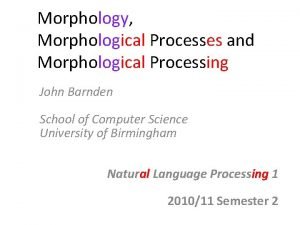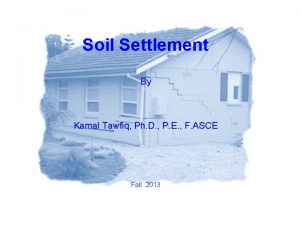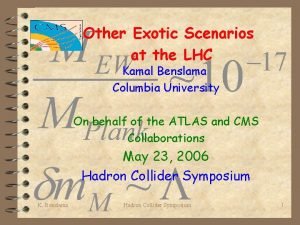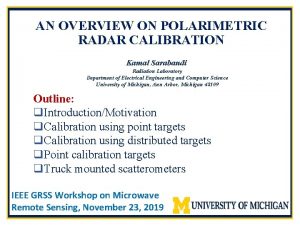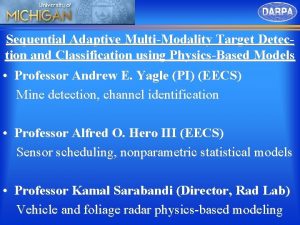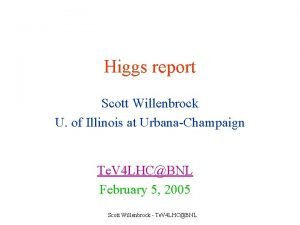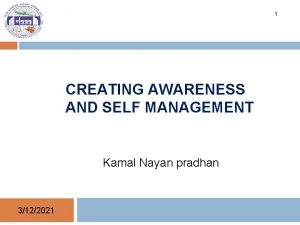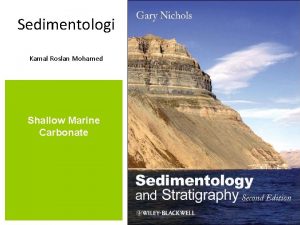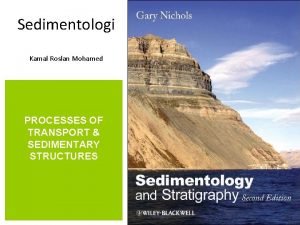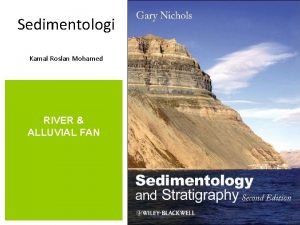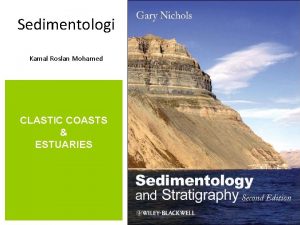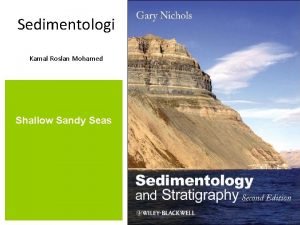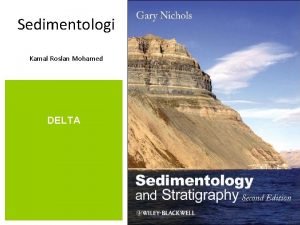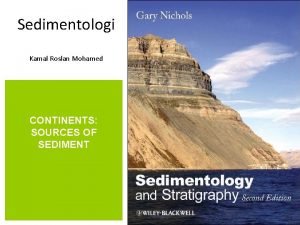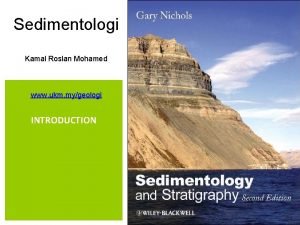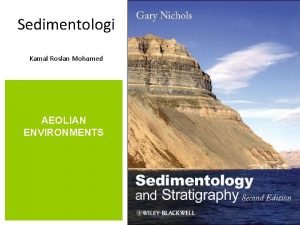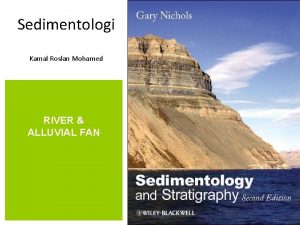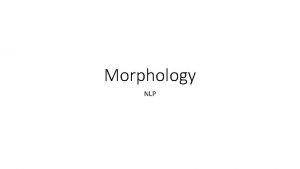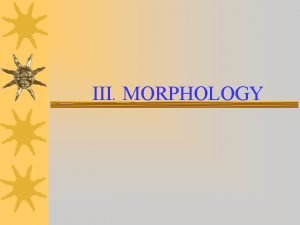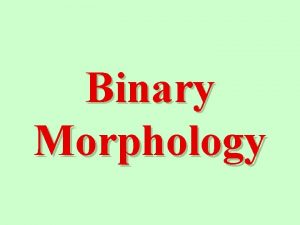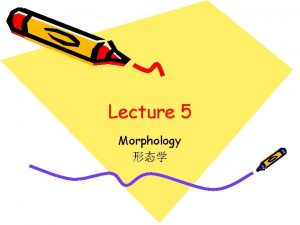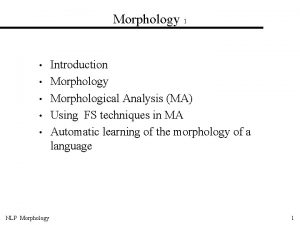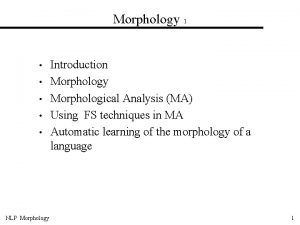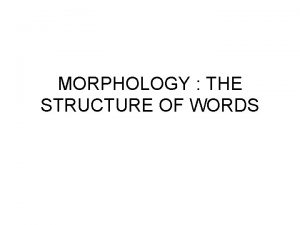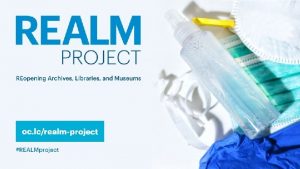Sedimentologi Kamal Roslan Mohamed MARINE REALM MORPHOLOGY PROCESSES





















- Slides: 21

Sedimentologi Kamal Roslan Mohamed MARINE REALM: MORPHOLOGY & PROCESSES

INTRODUCTION The oceans and seas of the world cover almost three-quarters of the surface of the planet and are very important areas of sediment accumulation. There is considerable variety in the sedimentation that occurs in the marine realm, but there a number of physical, chemical and biological processes that are common to many of the marine environments. Physical processes include the formation of currents driven by winds, water density, temperate and salinity variations and tidal forces: these have a strong effect on the transport and deposition of sediment in the seas. Chemical reactions in seawater lead to the formation of new minerals and the modification of detrital sediment. The seas also team with life: long before there was life on land organisms evolved in the marine realm and continue to occupy many habitats within the waters and on the sea floor.

DIVISIONS OF THE MARINE REALM The bathymetry, the shape and depth of the sea floor, is fundamentally determined by the plate tectonic processes that create ocean basins by sea-floor spreading. The spreading ridges areas of young, hot basaltic crust that is relatively buoyant and typically around 2500 m below sea level. Away from the ridges the water depth increases as the older crust cools and subsides, and most of the ocean floor is between about 4000 and 5000 m below sea level. A cross-section from the continental shelf through the continental slope and rise down to the abyssal plain.

DIVISIONS OF THE MARINE REALM At the ocean margins the transition from ocean crust to continental crust underlies the continental rise and the continental slope, which are the lower and upper parts of the bathymetric profile from the deep ocean to the shelf. The angle of the continental slope is relatively steep, usually between about 2° and 7°, while the continental rise is a lower angle slope down to the edge of the abyssal plain. The continental shelf itself is underlain by continental crust, and the junction between the shelf and the slope usually occurs at about 200 m below sea level at present-day margins A cross-section from the continental shelf through the continental slope and rise down to the abyssal plain.

INTRODUCTION The shelf area, down to 200 m water depth, is called the neritic zone, the bathyal zone corresponds to the continental slope and extends from 200 m to 2000 m water depth, while the abyssal zone is the ocean floor below 2000 m. Depth-related divisions of the marine realm: (a) broad divisions are defined by water depth; (b) the shelf is described in terms of the depth to which different processes interact with the sea floor, and the actual depths vary according to the characteristics of the shelf.

INTRODUCTION The shelf (neritic environment) can be usefully further divided into depth-controlled zones according to tidal processes, waves and storms affect the shelf. The foreshore is the region Depth-related divisions of the marine realm: (a) broad divisions are defined by water depth; between mean high water (b) the shelf is described in terms of the depth to which and mean low water marks different processes interact with the sea floor, and the of the tides actual depths vary according to the characteristics of the shelf. The shoreface is defined as the region of the shelf between the low-tide mark and the depth to which waves normally affect the sea bottom, and this is the fair weather wave base.

INTRODUCTION This deeper shelf area between the fair weather and storm wave bases is called the offshoretransition zone. The offshore zone is the region below storm wave base and extends out to the Depth-related divisions of the marine realm: (a) broad divisions are defined by water depth; shelfedge break at around (b) the shelf is described in terms of the depth to which 200 m depth. different processes interact with the sea floor, and the actual depths vary according to the characteristics of the shelf.

TIDES The Moon exerts a gravitational force on the Earth and although ocean water is strongly attracted gravitationally to the Earth, it also experiences a small gravitational attraction from the Moon. The water that is closest to the Moon experiences the largest gravitational attraction and this creates a bulge of water, a tidal bulge, on that side of the Earth. The gravitational force of the Sun and Moon act on the Earth and on anything on the surface, including the water masses in oceans. The bulge on the opposite side, facing away from the Moon, can be thought of as being the result of the Earth being pulled away from that water mass by the gravitational force of the Moon.

TIDES During the diurnal tidal cycle the direction of flow reverses from ebb (offshore) to flood (onshore). The current velocity also varies from peaks at the mid points of ebb and flood flow, reducing to zero at high and low tide slack water before accelerating again.

Sedimentary structures generated by tidal currents An analysis of current directions recorded by cross-bedding in sands deposited by tidal currents may show a bimodal (two main directions of flow) and bipolar (two opposite directions of flow) pattern. bipolar cross-stratification may be seen in a single ertical section produced by alternating directions of migration of ripples or dunes. This is known as herringbone crossstratification Herringbone cross-stratification in sandstone beds (width of view 1. 5 m).

Sedimentary structures generated by tidal currents At the time of high or low tide when the current is changing direction there is a short period when there is no flow. When the water is relatively still some of the suspended load may be deposited as a thin layer of mud. When the current becomes stronger during the next tide, the mud layer is not necessarily removed because the clay-rich sediment is cohesive and this makes it resistant to erosion. Mud drapes formed in this way can be seen in wave and current ripple laminated sands deposited in shallow water in places such as tidal mud flats. Features that indicate tidal influence of transport and deposition: (a) herringbone cross-stratification; (b) mud drapes on cross-bedding formed during the slack water stages of tidal cycles; (c) reactivation surfaces formed by erosion of part of a bedform when a current is reversed.

Sedimentary structures generated by tidal currents Cross-bedded sandstone in sets 35 cm thick with the surfaces of individual cross-beds picked out by thin layers of mud. Mud drapes on cross-beds are interpreted as forming during slack water stages in the tidal cycle.

WAVE AND STORM PROCESSES The depth to which surface waves affect a water body is referred to as the wave base and on continental shelves two levels can be distinguished. The fair weather wave base is the depth to which there is waveinfluenced motion under normal weather conditions. The storm wave base is the depth waves reach when the surface waves have a higher energy due to stronger winds driving them. Below the storm wave base the sea bed is not normally affected by surface waves.

MARINE FOSSILS Shelves areas of oxygenated waters periodically swept by currents to bring in nutrients. As such they are habitable environments for many organisms that may live swimming in water (planktonic) or on the sea floor (benthic), either on the surface or within the sediment. Plants and animals living in the marine realm contribute detritus, modify other sediments and create their own environments. Modern shelf environments team with life and it is rare to find an ancient shelf deposit that does not contain some evidence for the organisms that lived in the seas at the time.

TRACE FOSSILS Although body fossils provide physical evidence of an organism having lived in the past, trace fossils are evidence of the activity of an organism. Traces include tracks of walking animals, trails of worms, burrows of molluscs and crustaceans, and are collectively called ichnofauna.

TRACE FOSSILS Trace fossils are usually found on or within sediment that was unconsolidated but with sufficient strength to retain the shape of the animal’s trace. Contrasts in sediment type between a burrow and the host sediment are a considerable aid to recognition. A distinction is made between burrows formed in soft sediment and borings made by organisms into hard substrate. The characteristics of trace fossils are influenced by the nature of the substrate. Boring organisms cut sharpsided traces into solid rock or cemented sea floors (hardgrounds). Semiconsolidated surfaces (firmgrounds) result in well-defined burrows.

TRACE FOSSILS The different forms of trace fossils are given names similar to those used in the classification of animals and body fossils: so, for example, smaller vertical tubes in sands are called Skolithos and a crawling trail produced by a multilimbed organism is known as Cruziana.

TRACE FOSSILS Assemblages of trace fossil forms and their relationship to the major divisions of the marine realm. The assemblages are named after characteristic ichnofauna and the ‘type’ ichnofossil does not need to be present in the assemblage.

TRACE FOSSILS Examples of common trace fossils: (a) bird footprint; (b) bivalve borings into rock; (c) vertical burrows in sandstone (Skolithos); (d) large crustacean burrow (Ophiomorpha); (e) complex burrows (Thalassanoides); (f) Zoophycos; (g) Palaeodictyon; (h) Helmenthoides.

MARINE ENVIRONMENTS: SUMMARY The physical processes of tides, waves and storms in the marine realm define regions bounded by water depth changes. The beach foreshore is the highest energy depositional environment where waves break and tides regularly expose and cover the sea bed. At this interface between the land sea storms can periodically inundate lowlying coastal plains with seawater. Across the submerged shelf, waves, storms and tidal currents affect the sea bed to different depths, varying according to the range of the tides, the fetch of the waves and the intensity of the storms. Sedimentary structures can be used as indicators of the effects of tidal currents, waves in shallow water and storms in the offshore transition zone. Further clues about the environment of deposition are available from body fossils and trace fossils found in shelf sediments.

SEKIAN
 Derivational morphology and inflectional morphology
Derivational morphology and inflectional morphology Morphological processes compounding
Morphological processes compounding Word and word formation processes
Word and word formation processes Concurrent in os
Concurrent in os Moustapha kamal gueye
Moustapha kamal gueye Ahmad kamal
Ahmad kamal Dp
Dp How to learn written english by mostafa kamal
How to learn written english by mostafa kamal Kamal benslama
Kamal benslama Big data analytics raj kamal ppt
Big data analytics raj kamal ppt Kamal sarabandi
Kamal sarabandi Kamal nasr
Kamal nasr Kamal sarabandi
Kamal sarabandi Qantas mission statement
Qantas mission statement Larut matang selama map
Larut matang selama map Ambica international corporation
Ambica international corporation Kamal shehadi
Kamal shehadi Kamal sarabandi
Kamal sarabandi Shirin kamal
Shirin kamal Scott willenbrock
Scott willenbrock Kamal ke saman nayan
Kamal ke saman nayan Jason helmick
Jason helmick

